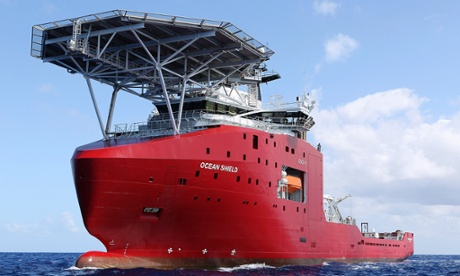Search chief says vessel's discovery is most promising lead, though not yet confirmation of the missing plane's location

A signal consistent with transmissions from the black box flight recorder and cockpit voice recorder of the missing Malaysia Airlines flight was picked up for more than two hours in the Indian Ocean, according to the head of Australia’s joint agency co-ordination centre.
In what may be one of the most promising leads yet in the search for the missing flight, the head of the Australian joint agency co-ordination centre, Angus Houston, announced on Monday that the Australian defence vessel Ocean Shield detected two separate signals within the northern part of the search area.
The first detection lasted two hours and 20 minutes, and the second lasted 13 minutes. The vessel is continuing to monitor the area to relocate the signal.
“Today I can report some very encouraging information which has unfolded over the last 24 hours. The towed pinger locator deployed from the Australian vessel Ocean Shield has detected signals,” he said.
“Significantly this would be consistent with transmissions from both the flight data recorder and the cockpit voice recorder.”
“All of the search underwater is being enabled by that wonderful work by the expert team in Kuala Lumpur. Their work has allowed us to come up with an underwater search area that is narrowly focused.”
Houston stressed that the lead, while promising, was not yet confirmation of the plane, but he said it was a “most promising lead”.
Malaysian officials announced two weeks ago they believed the plane was lost in the Indian Ocean with the loss of all passengers on board. While Malaysia bears responsibility for the investigation and recovery of the flight, Australia has been designated an “accredited representative” of the search after the prime minister, Tony Abbott, and the Malaysian prime minister, Najib Razak, met last Thursday to discuss the search.
On Sunday reports emerged through Chinese media outlets that a Chinese patrol ship, the Haixun 01, detected a pulse that could be from one of the black boxes of the missing plane.
Haixun 01 briefly picked up the signal again – almost 24 hours after the initial contact – and Ocean Shield also later detected a pulse about 300 nautical miles from the location of the Chinese vessel.
Nine military planes, three civilian planes and 14 ships are assisting in the search operation on Monday. Defence vessel Ocean Shield is operating within a smaller search area – believed to be the area with the highest probability of where the plane landed – and has a black box locator on board.
Monday’s search and recovery operation will cover an area of 234,000 square kilometres, and good weather conditions are expected. The Australian Transport Safety Bureau is continuing to refine the search zone.


No comments:
Post a Comment